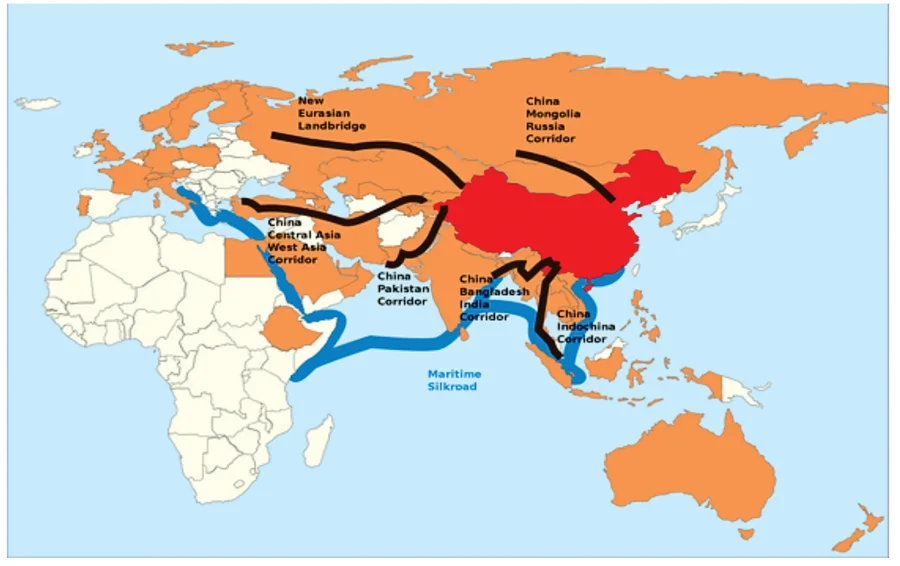IN recent years, the Belt and Road Initiative (BRI) has emerged as a major driving factor behind South Asian economic development, infrastructure and connectivity. The Belt and Road Initiative (BRI), launched by China in 2013, is a strategic framework aiming at encouraging global economic cooperation and integration through the development of a network of trade routes, infrastructure projects and financial investment. The idea has received both acclaim and criticism with proponents praising its potential to help poor countries and opponents raising worries about possible debt traps and geopolitical manoeuvring. Through infrastructure development, trade facilitation and people-to-people interactions, the BRI intends to improve regional cooperation and connectivity.
The CPEC is an important component of the BRI, serving as a corridor connecting Pakistan’s Gwadar Port to China’s north-western province, Xinjiang. The BRI is a large-scale initiative that aspires to connect Asia, Europe and Africa via land and sea routes. It is made up of two major components: the Silk Road Economic Belt which intends to build an economic corridor connecting China to Central and West Asia, and the Maritime Silk Road of the 21st Century, which wants to connect China to Southeast Asia, South Asia and the Middle East via maritime routes. The program aims to improve regional connections through constructing infrastructure, boosting commerce and facilitating investment in a variety of areas.
South Asia, with a population of nearly 2 billion, is a crucial region in the BRI framework due to its strategic location, abundant resources and skilled labour force. However, inadequate infrastructure hinders its progress. The BRI and CPEC offer opportunities for South Asian countries to develop infrastructure, increase connectivity and foster economic growth. The BRI and CPEC can stimulate regional connectivity, stimulate economic growth and foster stability. The transformative impact of the BRI and CPEC on Pakistan’s infrastructure benefits both countries and neighbouring countries, leading to increased connectivity within the region. The Belt and Road Initiatives promote regional economic cooperation through trade, investment and industrial development. They attract foreign investment and facilitate regional trade, while promoting cultural exchange and collaboration. However, transparency and inclusivity are crucial for successful implementation, as noted by Dr. Sarah Albinali, an expert on sustainable development.
South Asia has an abundance of energy resources. Regrettably, regional administrations and political instability have always squandered the chance to make the area an energy powerhouse. Energy security is an important part of regional connectivity and the BRI and CPEC play important roles in alleviating South Asia’s energy shortfalls. The energy projects of CPEC, which include coal, hydroelectric and renewable energy facilities, seek to relieve Pakistan’s energy problems while also contributing to regional power cooperation. The importance of CPEC’s energy investment is highlighted by energy security expert Mikkal Herberg: “CPEC’s energy projects offer an opportunity for Pakistan to diversify its energy mix, reducing its reliance on fossil fuels and promoting sustainable development.” The BRI and CPEC assist to regional stability by eliminating energy imbalances through improved energy cooperation.
Modern day competition among the nations is based on technological advancement and the advent of 5G technology. A further significant component of the BRI is the development of digital infrastructure, including 5G networks and the rise of e-commerce. The BRI has the potential to alter South Asia’s digital environment by creating new possibilities for businesses and consumers to interact and engage with one another. For example, the development of 5G networks may open up new avenues for businesses to produce novel products and services, while the spread of e-commerce may open up new avenues for consumers to access a broader choice of goods and services. The BRI’s deployment of 5G infrastructure has the potential to enable the development of smart cities in South Asia. 5G can allow effective urban planning, intelligent transport systems, and increased public services through the integration of Internet of Things (IoT) devices and advanced connectivity. 5G can facilitate effective data interchange and collaboration among neighbouring nations by building seamless networks and standardized protocols. According to Professor Xinghua Liu, a regional connectivity specialist, “the BRI’s 5G project can strengthen regional cooperation and facilitate cross-border trade, enabling South Asian countries to leverage their collective potential.”
Critics argue that the BRI projects may lead to unsustainable debt levels for participating countries, as they rely heavily on Chinese loans for financing. However, China’s focus on trade and cultural exchange, rather than arms and immunization, highlights the potential benefits of the initiative. South Asian countries must engage with the BRI to ensure it delivers on its promise of fostering connectivity and economic development.










